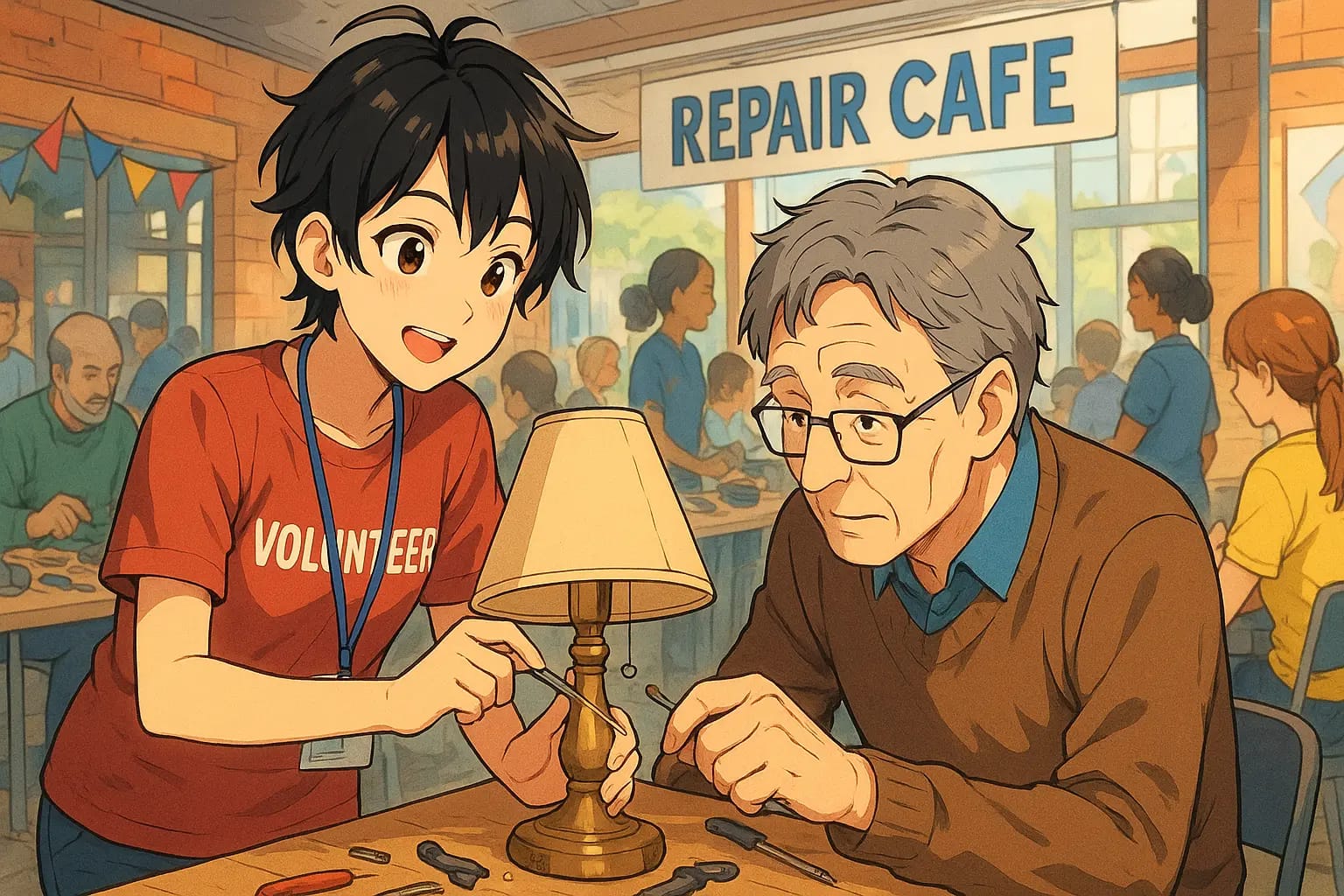Table of Contents
Repair Cafes in England: A Quiet Revolution of Mending
A cherished possession breaks. A well-loved lamp falls, a seam in a favourite coat rips, or a treasured clock simply ceases to tick. In that moment of disconnection, a familiar ache of disappointment arrives, followed by the logistical question: is it worth the time and expense to get this fixed? For many, the answer has long been no. The item is relegated to a drawer or, more often, a bin, destined to become another fragment of the United Kingdom’s staggering waste output.
Yet, a quiet, hopeful revolution is taking shape across England, driven not by political mandate but by a grassroots movement of skilled volunteers. In village halls, libraries, and community centres, a new kind of gathering is taking place. This is a powerful, profound movement, and its philosophy is as simple as it is timeless: to mend what is broken, one small fix at a time. This is the world of Repair Cafes England, and it is challenging the very foundation of our throwaway culture.
The Unhurried Origins: A Seed Planted in Amsterdam
The story of the repair café movement begins not on British soil, but in the Netherlands, with a single, compelling idea. In 2009, a Dutch journalist named Martine Postma observed a world where perfectly usable items were being needlessly discarded. Driven by a passion for local-level sustainability, she decided to act. On 18 October 2009, the very first Repair Café was held in Amsterdam. It was an experiment, a low-key meeting place where neighbours could bring their broken belongings and, with the help of skilled volunteers, attempt to fix them for free.[Read]
The event was a remarkable success, demonstrating that the initiative had tapped into a clear, widespread need. The momentum was undeniable. Just a few months later, on 2 March 2010, the Repair Café Foundation was established. Its purpose was to support local groups around the world who were eager to replicate Postma’s model, providing the guidance and resources needed to start their own community repair initiatives.
From that single event, the movement expanded with astonishing speed. By 2016, Postma had registered more than 1,000 Repair Cafés worldwide. This number more than doubled to over 2,000 by 2021, and by 2025, the global network had burgeoned to over 3,600 registered locations. The concept had found a universal resonance.
The arrival of the movement in England was a steady and organic progression. In 2016, there were just 22 registered Repair Cafés in the United Kingdom, a modest but promising start. By 2020, that number had grown exponentially to 125.[Read] More recent data reveals a continued, dramatic acceleration. In 2023, there were an estimated 250 repair cafes across England, Scotland, Northern Ireland, and Wales.[Read] Today, a vast network of over 600 such initiatives is supported by organisations like The Restart Project, a leading UK charity dedicated to tackling electronic waste.[Read]
The discrepancy between the officially registered numbers and the broader network statistics is not a contradiction but a powerful testament to the movement’s deeply decentralised, grassroots nature. While the Repair Café Foundation provides a valuable framework and brand, many independent groups, such as those in Bristol or Derbyshire, have spontaneously formed and operate without formal affiliation.
This dynamic demonstrates that the repair café is not merely a top-down initiative but a bottom-up cultural response to a widely felt need. It highlights the self-starting nature of communities in England, who, faced with a pervasive culture of waste, have simply decided to bypass formal processes and create their own solutions. This organic proliferation is the most powerful evidence of the movement’s profound cultural resonance and sustainability.
Weaving a New Social Fabric: The Heart of the Movement
At its core, a repair café is about far more than just fixing things. It is, in the words of the movement’s founder, a “creative, socially vibrant platform” that re-establishes repairing within a community.[Read] It is a tangible act of “commoning” where people share tools, spaces, knowledge, and skills, bridging divides and strengthening social bonds. The true value of a Repair Cafes England event is found not in the items repaired but in the human connections made across the workbench.
Consider the North Hampshire Repair Café, a bustling hub of activity where a team of 30 regular volunteers brings their varied expertise to the community. Led by an environmental advocate named Derek, the group holds monthly events in venues like St John’s Church and Sherfield Village Hall.[Read] The atmosphere is a vibrant hum of purpose and camaraderie.
Visitors are not merely dropping off their items; they are invited to stay, enjoy a hot drink, and watch as a team of fixperts brings their skills to bear on a wide array of challenges. The volunteers, who have a huge range of skills, range from James, who fixes watches and clocks, to Simon, a kit-car enthusiast, and Gary, who once managed to fix a 3D printer.
The stories that emerge from these events are intensely personal and powerful. Steve from Finchampstead brought in his portable Phillips television because it had started making clicking noises. “It’s a good TV and there’s nothing else wrong with it,” he explained. “I don’t want to buy a new one if this is fixable.” His sentiment is echoed by countless others.
Another visitor brought a cherished Big Ben Twilight Clock that had been sitting on a shelf for ages after its alarm quit ringing. A volunteer named Simon helped her take it apart, and as soon as he untangled a few wires, the alarm started ringing again. “I’m really pleased,” she said. “I’m grateful I’ll be able to use my clock again”. These are not just repairs; they are acts of preservation, saving not only an item but the memories and value attached to it.
The repair café is a powerful, albeit often overlooked, mechanism for bridging the generational divide. A 2016 study found that the average age of visitors to repair cafés was 53, with 86% of respondents aged over 45.[Read] This demographic reality presents a unique opportunity. Repair cafés provide a vital platform for an older, skilled generation of retired professionals and hobbyists to pass on “dying skillsets” to a younger generation raised in a consumerist, throwaway culture. This exchange is profoundly and mutually beneficial. Older volunteers find a deep sense of purpose, social connection, and a way to combat loneliness by giving “something back to the community”.
Meanwhile, younger visitors are empowered to mend their own belongings, gaining practical skills, building their “repairing confidence,” and cultivating a sense of agency that pushes back against the feeling of powerlessness in the face of modern consumer products.[Read] This model of “informal learning” addresses two major societal challenges at once: the social isolation of an aging population and the lack of practical skills in a younger one. It is, perhaps, the movement’s most significant and enduring social contribution.
A New Economy of Repair: Beyond the Scrap Heap
The social heart of the Repair Cafes England movement is accompanied by a robust and measurable environmental impact. At its core, the movement operates on the principles of the circular economy, an alternative to the traditional linear model of “take, make, and dispose”. By keeping materials in use for longer, repair cafés directly contribute to a reduction in waste and a significant mitigation of greenhouse gas (GHG) emissions.[Read]
A comprehensive 2018 study that analysed over 2,800 attempted repairs from 13 UK Repair Cafés provides a compelling data-driven picture of the movement’s effectiveness. The research found that on average, each successfully completed repair has the potential to save an estimated 24 kg CO₂ in GHG emissions. This is primarily achieved by displacing the need to purchase a new, replacement product.
To put this in perspective, this calculates to an average of 10kg CO₂ saved for every 1 kg of a product successfully repaired.[Read] When applied to the wider network, these small, individual fixes accumulate into monumental change. The North Hampshire group alone estimated that its work had prevented over a tonne of items from being thrown out. Globally, repair cafés prevented an estimated 420,000 kilos of waste in 2019.[Read]
| Product Category | Average Repair Success Rate | Average Embodied GHGs Saved (kg CO₂) per repair | Payback Period (Life in years to offset repair GHGs) |
| Clothing & Textiles | 89% | 17.8 | 1.1 |
| Household Appliances | 67% | 25.5 | 1.3 |
| Bicycles | 67% | 149.6 | 0.6 |
| Audio & AV/Photo | 67% | 66.1 | 0.6 |
| Tools (non-electric) | 67% | 4.6 | 15.6 |
| Computing, IT & Mobile | 37% | 201.7 | 0.1 |
The study also reveals a fascinating and crucial detail: over half of all completed repairs (52%) required the use of no spare parts at all. The most common repair was simply re-stitching clothing or fixing faulty electrical connections. This observation suggests that the primary barrier to repair is often not a lack of available parts but a lack of knowledge or confidence to diagnose and fix a simple fault.
The real problem isn’t a broken component but a broken mindset—the ingrained belief that an item is beyond repair. Repair cafés provide the missing piece of the puzzle: not a spare part, but the guidance, tools, and encouragement to empower individuals to overcome this psychological hurdle. The very act of helping a visitor diagnose and mend a small appliance builds a “repairing confidence” that can lead to a long-term shift in behaviour.
“You begin to realise that you can solve problems with your own hands. It is this mindset that we need for a sustainable future.” — Martine Postma, Founder.[Read]
However, the analysis of the movement’s environmental impact also reveals a complex challenge that highlights the subtle conflict between the repair café’s mission and the deeply ingrained culture of consumerism. A concept known as “rebound consumption” can offset a portion of the GHG savings. This occurs when a repair is free or nearly free, and the money saved might be spent on new, unrelated goods, which in turn creates new greenhouse gas emissions. The research estimates that this rebound effect can create an additional 4.4 kg CO₂ in emissions per completed repair, a significant figure that slightly diminishes the net environmental benefit.
This finding demonstrates that the true goal of the repair movement is not just to fix things but to fundamentally change behaviour. The community atmosphere of a repair café—focused on shared resources, collaborative effort, and the act of valuing a restored item—is the antidote to this rebound effect. It works against the psychological impulse to buy something new, proving that the repair café is not just an environmental initiative but a form of cultural resistance.
The Call for Change: Mending a Broken System
The quiet revolution of community repair is happening on the ground, but its full potential can only be realised if the system itself is mended. This is the core principle of the global “Right to Repair” movement, a campaign for a legal right for consumers and independent repair providers to access the parts, tools, and information needed to fix their own goods.[Read]
The need for this policy is rooted in the pervasive practice of planned obsolescence, a growing problem whereby products are intentionally designed to fail or become obsolete after a short period of time. Manufacturers often use glue, proprietary screws, or “parts pairing” with software locks to make products difficult or impossible to repair without a trip to an official repair centre, at a substantial cost. The data collected by community groups shows that simple faults are often the cause of an item’s demise, and the lack of accessible manuals and parts is the primary barrier to their resurrection.
The UK has taken a crucial, albeit limited, step forward with the new Right to Repair law, which came into force on 1 July 2021. The legislation requires manufacturers to make spare parts and repair manuals available for up to ten years for certain new white goods and televisions.[Read] This is a positive development, giving consumers the choice to fix their appliances or hire a third party to do so. It aims to extend the life cycle of these devices, reducing e‑waste and the associated environmental costs.
However, the current law has significant blind spots that reveal a fundamental disconnect between the policy and the grassroots reality of community repair. The legislation applies to a limited range of products, explicitly excluding popular electronics like laptops and smartphones. Moreover, it often restricts access to essential parts and manuals to “professional repairers” only, explicitly excluding consumers and, by extension, volunteer-led initiatives like repair cafés.
This creates a profound irony where the law meant to encourage repair instead sidelines the very non-commercial, volunteer-led movement that is driving the cultural change. Organizations such as The Restart Project are working to close this gap by collecting and analysing repair data to influence policy, advocating for universal access to manuals and parts for all.
| Aspect of Repairability | Provisions of Current UK Law | Demands of the Right to Repair Movement |
| Access to Parts | Required for certain white goods and televisions for up to 10 years after production stops. | Required for all electrical and electronic products. |
| Access to Manuals | Available to professional repairers only for certain products. | Manuals and design schematics should be freely available to everyone, including consumers and community groups. |
| Scope of Covered Products | Limited to washing machines, washer-dryers, dishwashers, fridges, and televisions. | Should be expanded to include laptops, smartphones, tablets, and all other consumer electronics. |
| Pricing of Parts | No cap on how much manufacturers can charge for spare parts. | Parts should be available at a fair, non-discriminatory price. |
| Software Locks | Does not address the practice of ‘parts pairing’ or software locks. | Legislation should ban software pairing that prevents the use of third-party or salvaged parts. |
Your Invitation to Tinker: How to Join the Movement
The beauty of the Repair Cafes England movement lies in its accessibility. It is a simple invitation to participate in a profound change. The experience of a typical visit is structured to be collaborative and educational, not a simple drop-off service. A visitor brings one item to a local event, registers it at a reception desk, and then works directly with a volunteer fixer. There is a sense of collective purpose, with visitors waiting their turn, swapping stories over a cup of tea, and watching as other repairs unfold.[Read] The process is designed to empower; the focus is on learning how to mend, not just having a thing mended for you.[Read]
The range of items that can be repaired is broad and surprising. While the most common are household appliances and clothing, repair cafés can also handle bicycles, lamps, furniture, toys, and even jewellery.[Read] Some initiatives even offer services for house plants, bicycle repairs, or decorative gilded mending.[Read] However, it is always wise to check with the local café beforehand to see what skills and specialities will be available on the day.[Read]
The movement is not just for the technically skilled. There is a role for everyone. While expert fixperts are the heart of the operation, repair cafés need a range of volunteers to run smoothly. Many initiatives are looking for hosts and hostesses to greet visitors, manage the flow of repairs, and offer refreshments.[Read] There are also opportunities for those who can help with online communications, event promotion, and general administration. The true power of the movement comes from its diverse and welcoming community.
Frequently Asked Questions (FAQ)
Q. What is a Repair Cafe?
Ans: A Repair Cafe is a free, community-led event where people bring broken household items and work with skilled volunteers to fix them. The core purpose is to reduce waste by encouraging repair and to foster skill-sharing and social cohesion in the community.
Q. How do Repair Cafes work?
Ans: The process is straightforward. Visitors bring one broken item and register at a reception desk. A volunteer fixer will then work with the visitor to diagnose the problem and, if possible, perform the repair together. The service is not a drop-off model; visitors are expected to stay and participate in the repair process.
Q. What can you get repaired at a Repair Cafe?
Ans: The range of repairable items is quite broad, including clothes, small electrical appliances, furniture, toys, bicycles, and sometimes even jewellery and electronics. The most common repairs are for household appliances and textiles. It is always recommended to check with the local cafe beforehand to confirm they have the right skills available for your specific item.
Q. Are Repair Cafes free?
Ans: Yes, the service itself is free of charge. The volunteers do not ask for a fee for their time or expertise. However, most repair cafés are run on donations, and visitors are encouraged to make a voluntary contribution to help cover essential running costs like venue hire, insurance, and materials.
Q. How can I find a Repair Cafe near me in England?
Ans: Many local councils, community groups, and transition town networks maintain lists of local repair cafés. The international Repair Café Foundation also provides a global map. The most effective way to find a local event is to search online for “Repair Cafes England near me” or a specific town name, which will often lead to a local listing on a community website or a social media page.
The Quiet Rise of a Better Tomorrow
The quiet rise of Repair Cafes England is a powerful story of community, resilience, and hope. It is a movement that has grown from a single, simple idea into a global phenomenon with a tangible, measurable impact on waste reduction and carbon emissions. It is a social lifeline that builds community and bridges generations, providing purpose to volunteers and empowerment to visitors.
In a world that often feels fractured and disconnected, the repair café offers a powerful antidote. It challenges a culture of perpetual consumption and planned obsolescence by proving that things do not have to be thrown away. It reconnects us with our belongings, our skills, and our neighbours, one small fix at a time. The next time a treasured item breaks, do not rush to replace it. Find your local repair café, bring that item with you, and become a part of this quiet, hopeful, and transformative revolution.
Engage with our curated reflections on Money, Design, and Economics—crafted for discerning minds. Share your perspective, and become part of a dialogue that shapes tomorrow’s world.



